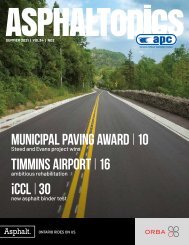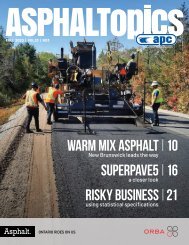ASPHALTopcs | Summer 2017 | VOL 30 | NO 2
Create successful ePaper yourself
Turn your PDF publications into a flip-book with our unique Google optimized e-Paper software.
TECHNICALLY<br />
SPEAKING<br />
by Vince Aurilio<br />
Executive Director, OAPC<br />
Intersections: Approach with caution<br />
of a racetrack or a runway). In fact,<br />
slow-moving heavy vehicles at an<br />
intersection actually put more stress<br />
on pavements than those moving<br />
faster.<br />
RR20 Lundy’s lane at Drummond Road, City of Niagara Falls,<br />
rehabilitated in 2011/2012. (Niagara Region)<br />
The same traffic conditions that add to the stress<br />
of driving at intersections (about <strong>30</strong> per cent of<br />
fatalities occur at intersections) 1 also add to the stress<br />
on pavements. Whether you are a driver or pavement<br />
engineer, you should approach intersections with care.<br />
Urban traffic conditions have brought the challenge<br />
of designing pavement for intersections to the top of<br />
the agenda for municipal engineers. The heavy traffic,<br />
braking, accelerating and turning that contribute to the<br />
wear and tear on asphalt are becoming increasingly<br />
severe. Traffic is getting more congested, tire pressures<br />
are increasing, and trucks and buses are heavier.<br />
It is not just the volume of traffic that should be of<br />
concern. Intuitively, most people associate the speed<br />
of the vehicle with the stress on the pavement (think<br />
Engineers need to pay particular<br />
attention to design and material<br />
selection to ensure that the asphalt<br />
pavement at intersections provides<br />
the same outstanding performance<br />
and life-cycle cost benefits as it<br />
does elsewhere.<br />
Rutting is probably the most common indication<br />
of pavement failure at an intersection and can be<br />
the result of inadequacy of the pavement structure,<br />
poor consolidation (compaction), and/or plastic flow<br />
(permanent deformation). The Asphalt Institute in<br />
the U.S. has developed a basic strength approach<br />
to designing pavements at intersections that<br />
addresses all three failure mechanisms:<br />
1. Ensure structural adequacy.<br />
2. Select and control materials.<br />
3. Follow proper construction practices.<br />
As you would expect, aggregates play a very important<br />
role in all three steps.<br />
The most common failure mechanism at intersections<br />
is plastic flow (rutting), and material selection is key in<br />
34 OAPC | ASPHALTOPICS

















